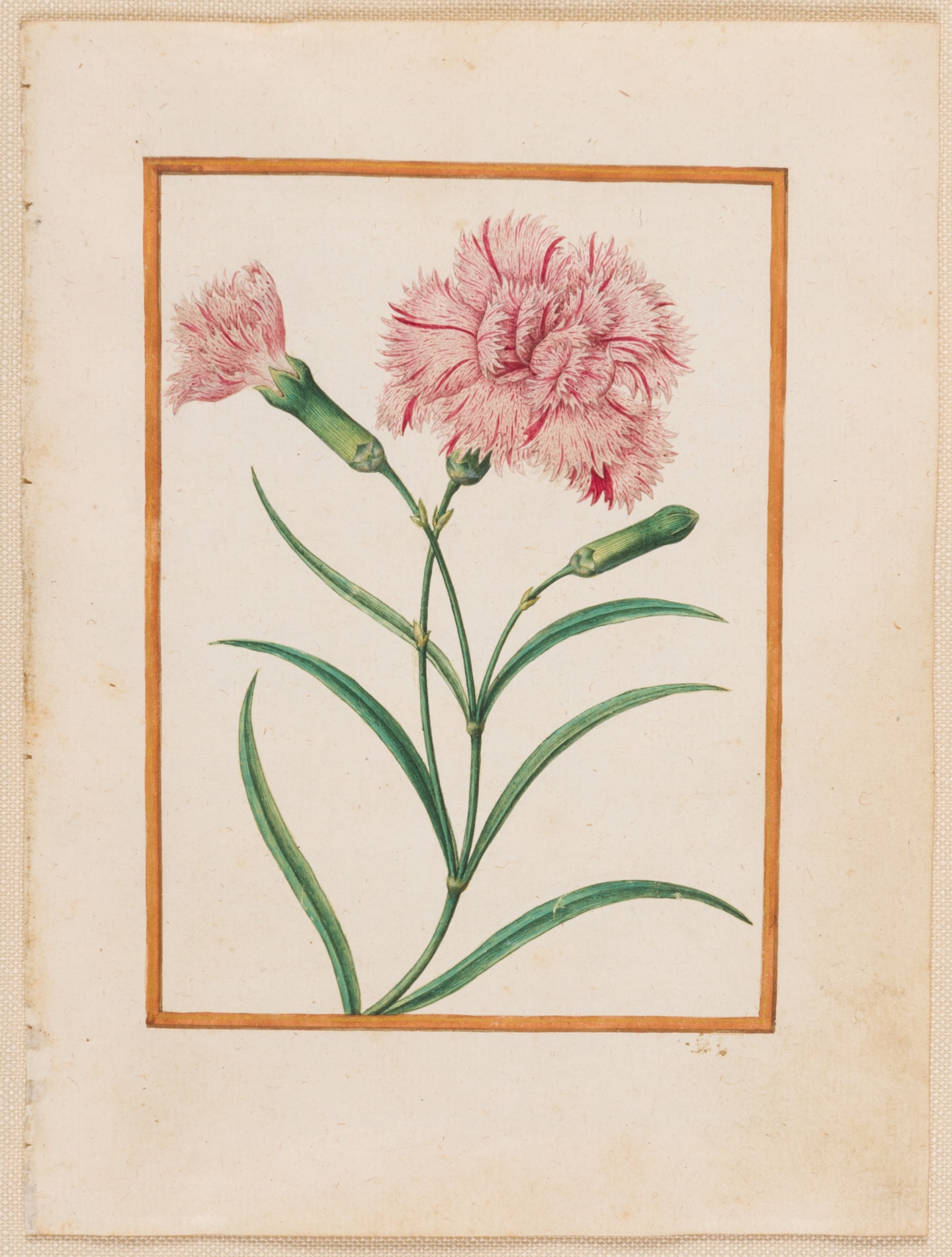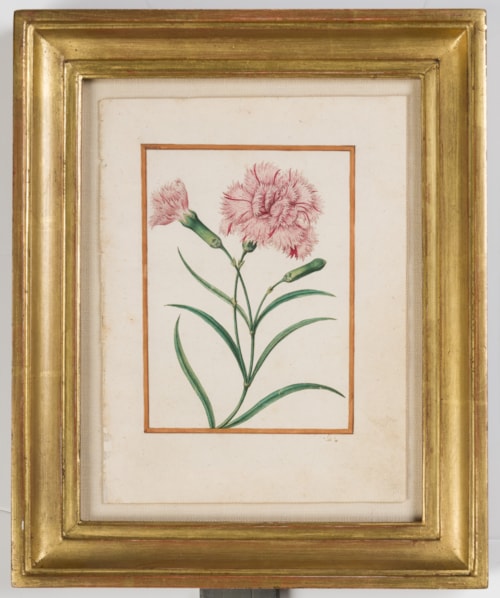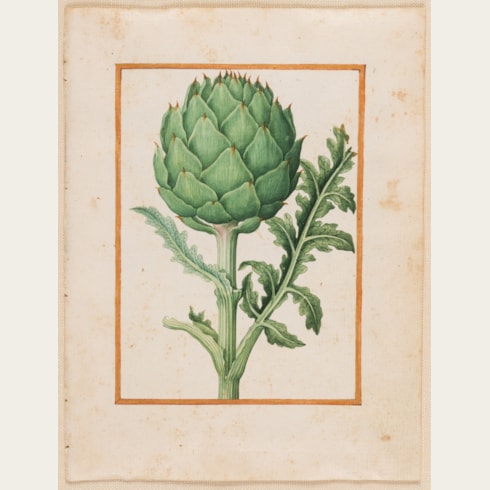Jacques LE MOYNE DE MORGUES
(Dieppe c.1533 - London 1588)
Clove Pinks (Dianthus caryophyllus)
Watercolour and gouache on paper prepared as vellum, with framing lines in brown ink and watercolour.
139 x 100 mm. (5 1/2 x 4 in.) [image]
195 x 145 mm. (7 5/8 x 5 3/4 in.) [sheet]
139 x 100 mm. (5 1/2 x 4 in.) [image]
195 x 145 mm. (7 5/8 x 5 3/4 in.) [sheet]
The present sheet comes from perhaps the earliest, and certainly the largest, compendium of botanical studies by Jacques Le Moyne to be discovered; an album of eighty drawings in watercolour and gouache - together with an elaborate frontispiece in the form of an architectural cartouche below which is the name ‘Du Marry’ - that appeared at auction in New York in 2005. The drawings from this album may date to the mid to late 1560s, when Le Moyne was still working in France, and as such are probably earlier in date than those found in the albums in the Victoria and Albert Museum and the British Museum. While several of the plants depicted in the ‘Du Marry’ album also appear in the other known albums, Le Moyne was careful to make each watercolour composition different from others of the same species. Characterized by elegant compositions enclosed in fictive frames, the watercolours in the ‘Du Marry’ album are drawn on paper smoothed with a stone to achieve a vellum-like surface. The paper is almost identical to that found in the Victoria and Albert florilegium, which is closest to the ‘Du Marry’ album in conception, appearance and date.
Le Moyne’s ‘Du Marry’ album is one of the earliest French florilegia known. A compendium of images of flowering plants, studied directly from nature, a florilegium was related to the herbal; an early form of plant book providing exacting descriptions of plants for medicinal purposes. The rise of exploration in the 16th century brought many new plants to Europe, and stimulated a concurrent interest in garden design. There was also much demand, among collectors and scholars of exotic plants, for artists to record their transient beauty. Le Moyne was among the leading 16th century artists who specialized in the production of elaborate painted florilegia, and his splendid work in this field found a particularly receptive audience in Elizabethan England.
As the scholar Paul Hulton has noted of Le Moyne’s watercolours in the British Museum album, in terms equally applicable to the present sheet, ‘The drawings are nearly all of plants then commonly found in French or English gardens…They show an exquisite attention to detail, yet are drawn with a deep understanding and love of the subject which avoids all traces of superficial prettiness. They are plant portraits which delight the eye and at the same time satisfy to a remarkable extent the scientific requirements of the botanist. The combination of these virtues is very rarely found to the same degree at this period.’
The wild ancestor of the garden carnation, the clove pink is a plant with clove-scented flowers, and was used as a medicinal and culinary herb, as an aromatic and for flavouring. Le Moyne seems to have been particularly fond of clove pinks, which appear several times in his oeuvre. The ‘Du Marry’ album, from which the present sheet originates, included two other studies of clove pinks, albeit each very different in composition. A similar study of a clove pinks is also found in the album of watercolours of flowers, fruit and butterflies by Le Moyne in the Victoria and Albert Museum in London. A depiction of clove pinks with a small butterfly by Le Moyne was part of a group of six small gouache drawings on vellum, formerly in the manuscript collection of Eric Korner, which were sold at auction in 1997. A sheet of studies of five clove pinks, drawn in watercolour and gouache in a more informal manner, was sold at auction in New York in 2004.
Le Moyne’s ‘Du Marry’ album is one of the earliest French florilegia known. A compendium of images of flowering plants, studied directly from nature, a florilegium was related to the herbal; an early form of plant book providing exacting descriptions of plants for medicinal purposes. The rise of exploration in the 16th century brought many new plants to Europe, and stimulated a concurrent interest in garden design. There was also much demand, among collectors and scholars of exotic plants, for artists to record their transient beauty. Le Moyne was among the leading 16th century artists who specialized in the production of elaborate painted florilegia, and his splendid work in this field found a particularly receptive audience in Elizabethan England.
As the scholar Paul Hulton has noted of Le Moyne’s watercolours in the British Museum album, in terms equally applicable to the present sheet, ‘The drawings are nearly all of plants then commonly found in French or English gardens…They show an exquisite attention to detail, yet are drawn with a deep understanding and love of the subject which avoids all traces of superficial prettiness. They are plant portraits which delight the eye and at the same time satisfy to a remarkable extent the scientific requirements of the botanist. The combination of these virtues is very rarely found to the same degree at this period.’
The wild ancestor of the garden carnation, the clove pink is a plant with clove-scented flowers, and was used as a medicinal and culinary herb, as an aromatic and for flavouring. Le Moyne seems to have been particularly fond of clove pinks, which appear several times in his oeuvre. The ‘Du Marry’ album, from which the present sheet originates, included two other studies of clove pinks, albeit each very different in composition. A similar study of a clove pinks is also found in the album of watercolours of flowers, fruit and butterflies by Le Moyne in the Victoria and Albert Museum in London. A depiction of clove pinks with a small butterfly by Le Moyne was part of a group of six small gouache drawings on vellum, formerly in the manuscript collection of Eric Korner, which were sold at auction in 1997. A sheet of studies of five clove pinks, drawn in watercolour and gouache in a more informal manner, was sold at auction in New York in 2004.
The extraordinary life, career and work of the 16th century Huguenot artist Jacques Le Moyne has only relatively recently been studied. He seems to have been born in Dieppe around 1533, and it is supposed that he received his training as an artist there, but little else is known of the first thirty years of his life and career. He may have worked at the court of King Charles IX, and is first recorded as an official artist and cartographer attached, at the King’s behest, to the 1564-1565 Huguenot expedition to northern Florida. The expedition, led by René Goulaine de Laudonnière, was intended to relieve a small Huguenot colony founded earlier by Jean Ribaut and hopefully establish a new French Protestant settlement there. Le Moyne’s task was to map the Florida coastline and riverways, and to make drawings of the natives, their villages, and anything else worthy of observation.
Beset by a lack of provisions and reliant on the sometimes-hostile native Indians for food, as well as a mutiny among some of the troops accompanying them, many members of the expedition died of starvation or disease. Although much of the remaining French garrison was attacked and killed by Spanish forces in the autumn of 1565, Le Moyne and a few dozen Frenchmen, including Laudonnière, managed to escape the massacre. They travelled overland for three days, through swamps and rivers with little or no food, before reaching the coast and one of Ribaut’s ships. The fifteen survivors of the expedition sailed back to Europe, unexpectedly landing in Wales in 1565. On his return to France, Le Moyne presented his maps and drawings of the Florida natives to Charles IX, who had supported Laudonnière’s expedition. (Only one original drawing by Le Moyne from the Florida expedition survives today, however; a drawing in watercolour and gouache on vellum of The Indian Chief Athore Showing Laudonnière the Marker Column Set Up by Ribaut, now in the collection of the New York Public Library.) Le Moyne wrote an account of the ill-fated Florida expedition, illustrated with engravings after his drawings and maps, which was only published in 1591, after his death, with the title Brevis narratio eorum quae in Florida Americae provincia Gallis acciderunt.
Like many of his Huguenot compatriots, Le Moyne escaped from France after the 1572 Saint Bartholomew’s Day massacre of Huguenots by Catholics. He settled in England, adding ‘de Morgues’ to his name, and soon gained the patronage of such significant figures of the era as Sir Walter Raleigh and Lady Mary Sidney, which allowed him to concentrate in particular on small-scale botanical studies. (He was also an influence on the English artist, explorer and colonist John White, with whom he collaborated.) In London in 1586 Le Moyne published a series of simple woodcuts of flora and fauna with the title Le clef des champs, pour trouver plusieurs animaux, tant bestes qu’oyseaux, avec plusieurs fleurs et fruitz, intended as a sort of model book for artists and dedicated to Lady Sidney. It was also around this time that Le Moyne drew the extraordinary gouache known as The Young Daughter of the Picts - a fantastical depiction of a woman whose body is entirely covered with beautifully painted flowers – which is today in the Yale Center for British Art in New Haven. Firmly established as a highly-regarded botanical artist, Le Moyne lived in the parish of Saint Anne’s in Blackfriars until his death in 1588.
Previously known for the ethnographic drawings he produced during his travels, Le Moyne was only recognized as an important botanical painter in the early 20th century. In 1922 Spencer Savage, the librarian of the Linnean Society, identified Le Moyne as the artist responsible for a small album containing fifty-nine watercolours of flowers, fruit and butterflies in the Victoria and Albert Museum in London. Le Moyne seems to have produced a number of such albums of botanical watercolour drawings. Apart from that in the Victoria and Albert Museum, a volume of fifty studies of flowers and fruit, dated 1585, appeared at auction in 1961 and is today in the British Museum, while a further example, containing sixty drawings in watercolour and gouache, is in the Rachel Mellon collection at the Oak Spring Garden Library in Upperville, Virginia.
Apart from the four florilegia albums known, other groups of drawings by Le Moyne include a set of fourteen miniatures of flower, fruit and insects, painted in gouache on vellum; eight of which are at the Dumbarton Oaks Library in Washington, D.C. and another six which were formerly in the Eric Korner collection and were sold at auction in New York in 1997. Another group of twenty-seven study sheets of flowers, fruit, birds and insects by Le Moyne, drawn in a more informal manner, was dispersed at auction in 2004; five of these reappeared at auction in New York in 2019.
Beset by a lack of provisions and reliant on the sometimes-hostile native Indians for food, as well as a mutiny among some of the troops accompanying them, many members of the expedition died of starvation or disease. Although much of the remaining French garrison was attacked and killed by Spanish forces in the autumn of 1565, Le Moyne and a few dozen Frenchmen, including Laudonnière, managed to escape the massacre. They travelled overland for three days, through swamps and rivers with little or no food, before reaching the coast and one of Ribaut’s ships. The fifteen survivors of the expedition sailed back to Europe, unexpectedly landing in Wales in 1565. On his return to France, Le Moyne presented his maps and drawings of the Florida natives to Charles IX, who had supported Laudonnière’s expedition. (Only one original drawing by Le Moyne from the Florida expedition survives today, however; a drawing in watercolour and gouache on vellum of The Indian Chief Athore Showing Laudonnière the Marker Column Set Up by Ribaut, now in the collection of the New York Public Library.) Le Moyne wrote an account of the ill-fated Florida expedition, illustrated with engravings after his drawings and maps, which was only published in 1591, after his death, with the title Brevis narratio eorum quae in Florida Americae provincia Gallis acciderunt.
Like many of his Huguenot compatriots, Le Moyne escaped from France after the 1572 Saint Bartholomew’s Day massacre of Huguenots by Catholics. He settled in England, adding ‘de Morgues’ to his name, and soon gained the patronage of such significant figures of the era as Sir Walter Raleigh and Lady Mary Sidney, which allowed him to concentrate in particular on small-scale botanical studies. (He was also an influence on the English artist, explorer and colonist John White, with whom he collaborated.) In London in 1586 Le Moyne published a series of simple woodcuts of flora and fauna with the title Le clef des champs, pour trouver plusieurs animaux, tant bestes qu’oyseaux, avec plusieurs fleurs et fruitz, intended as a sort of model book for artists and dedicated to Lady Sidney. It was also around this time that Le Moyne drew the extraordinary gouache known as The Young Daughter of the Picts - a fantastical depiction of a woman whose body is entirely covered with beautifully painted flowers – which is today in the Yale Center for British Art in New Haven. Firmly established as a highly-regarded botanical artist, Le Moyne lived in the parish of Saint Anne’s in Blackfriars until his death in 1588.
Previously known for the ethnographic drawings he produced during his travels, Le Moyne was only recognized as an important botanical painter in the early 20th century. In 1922 Spencer Savage, the librarian of the Linnean Society, identified Le Moyne as the artist responsible for a small album containing fifty-nine watercolours of flowers, fruit and butterflies in the Victoria and Albert Museum in London. Le Moyne seems to have produced a number of such albums of botanical watercolour drawings. Apart from that in the Victoria and Albert Museum, a volume of fifty studies of flowers and fruit, dated 1585, appeared at auction in 1961 and is today in the British Museum, while a further example, containing sixty drawings in watercolour and gouache, is in the Rachel Mellon collection at the Oak Spring Garden Library in Upperville, Virginia.
Apart from the four florilegia albums known, other groups of drawings by Le Moyne include a set of fourteen miniatures of flower, fruit and insects, painted in gouache on vellum; eight of which are at the Dumbarton Oaks Library in Washington, D.C. and another six which were formerly in the Eric Korner collection and were sold at auction in New York in 1997. Another group of twenty-seven study sheets of flowers, fruit, birds and insects by Le Moyne, drawn in a more informal manner, was dispersed at auction in 2004; five of these reappeared at auction in New York in 2019.
Provenance
Part of an album belonging to 'Du Marry’ (according to an inscription on the frontispiece of the album)
Anonymous sale, New York, Sotheby’s, 26 January 2005, part of lot 46 (the album sold for $1,136,000)
W. Graham Arader, New York.
Anonymous sale, New York, Sotheby’s, 26 January 2005, part of lot 46 (the album sold for $1,136,000)
W. Graham Arader, New York.
Literature
Monique Kornell and Dániel Margóscy, ‘‘A Spring of Immortal Colours’. Jacques Le Moyne de Morgues (c.1533-1588) and Picturing Plants in the Sixteenth Century’, Journal of the Warburg and Courtauld Institutes, 2023, p.122, note 43.






